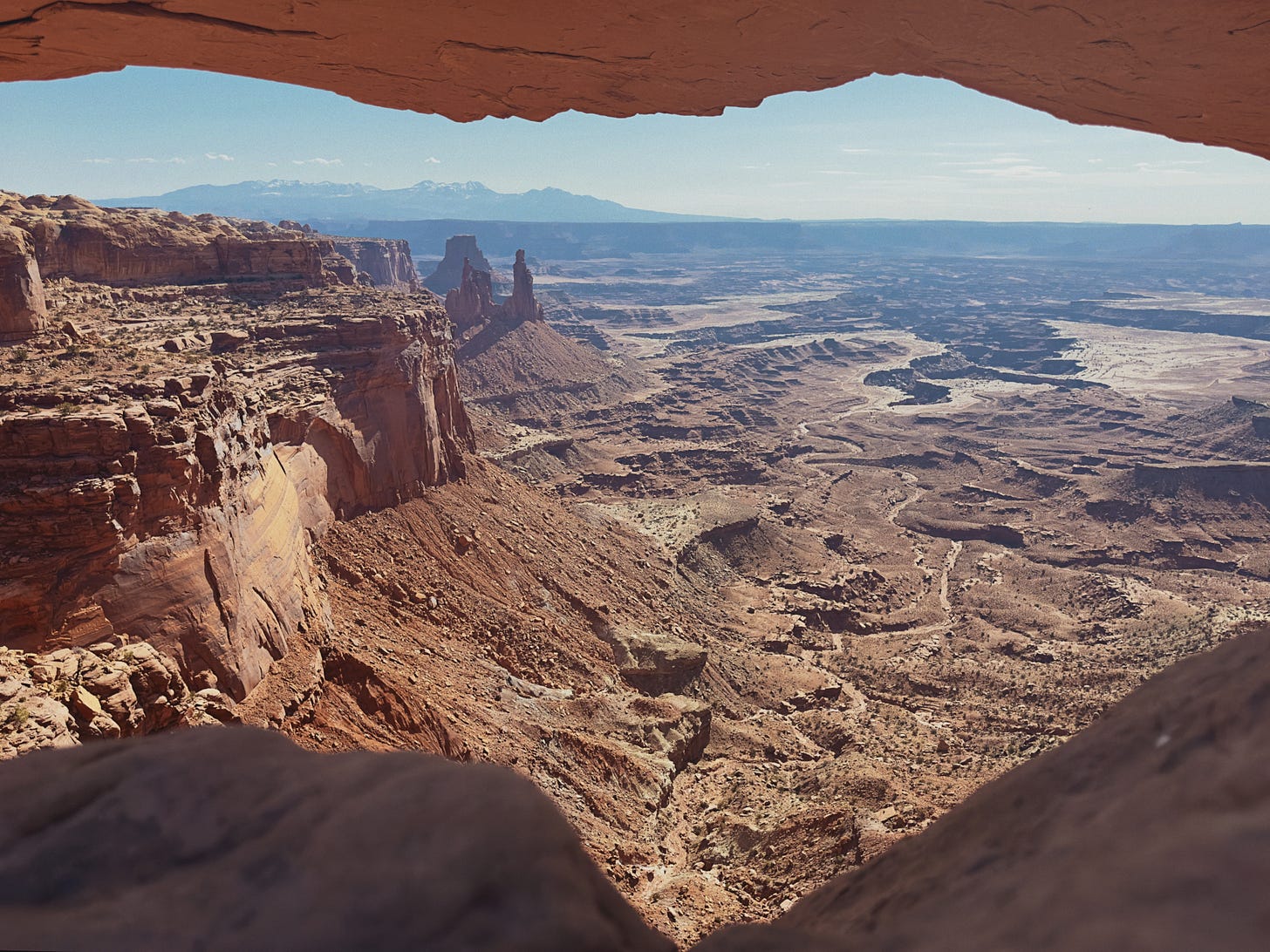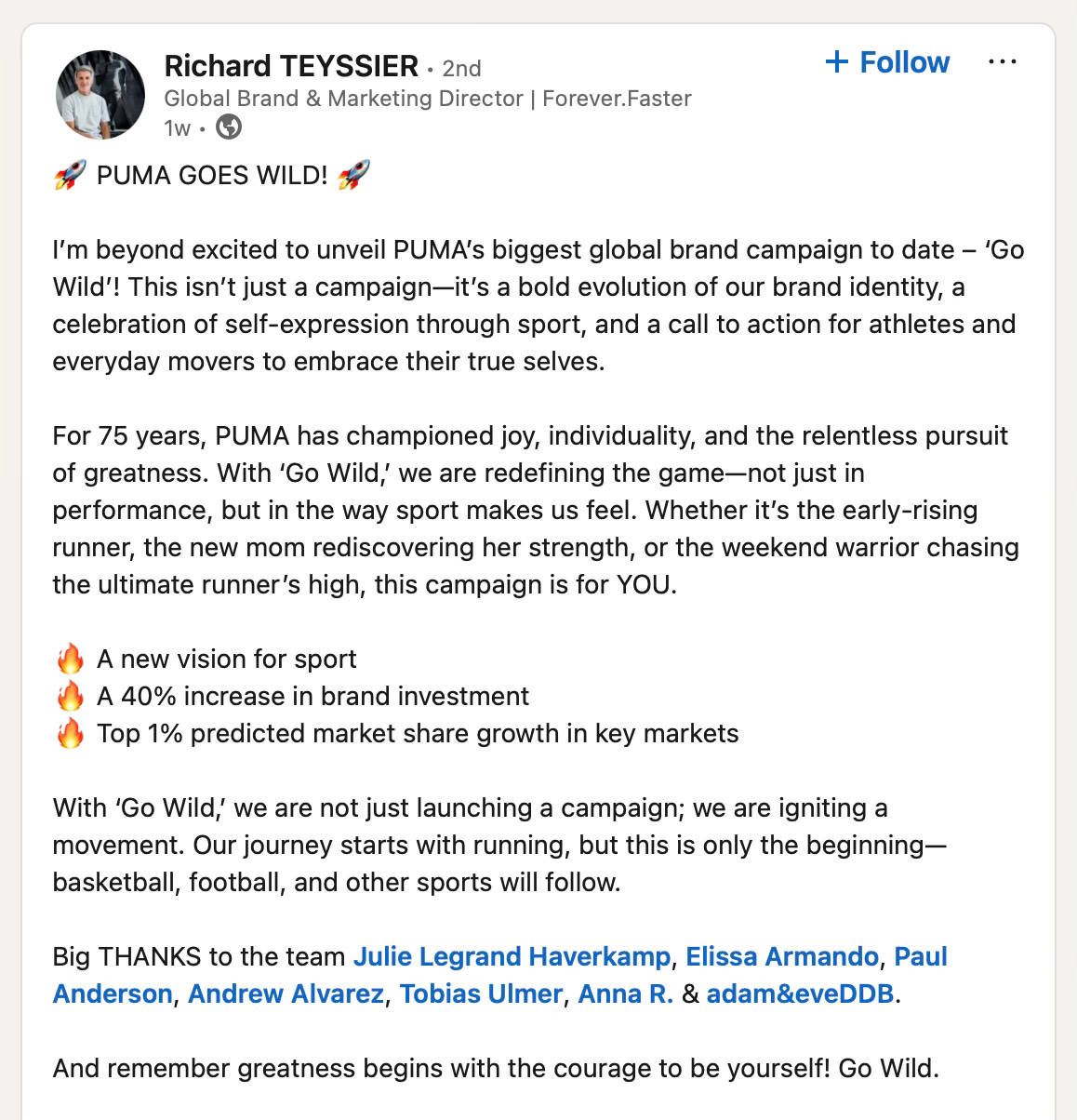Athletes as Employees, World Building, and Puma.
How to better involve athletes in corporate roles, World building is filling a void left by the TV Remote and is Puma actually high?
Hi team, it’s been a minute.
I just wrapped an amazing spring break with the family in Moab. If you haven’t made a visit in the spring I’d call it a must-do. The weather is amazing and the running and hiking options in Arches, Canyonlands and the surrounding area are endless.
I’ve been asked to be an Advisory Board Member for TrailCon, the trail running industry conference taking place in June between Broken Arrow Skyrace and Western States. I’m excited to work with the amazing and influential people on the board and help shape what is becoming an important gathering for the future of the sport.
The Athlete/Employee Opportunity
As I’ve watched the sponsor contracts shake out we’ve seen athletes jump to new sponsors and brands painfully drop other athletes, some teams have grown and others have shrunk (is Courtney really Salomon’s only North American athlete?). Most of this happens just about every year. One new trend that has stood out to me is the established athletes taking on contracts that include defined internal corporate roles in marketing or product development.
It’s standard for athletes to be involved in product testing/feedback but I can’t think of many with formal positions outside of “athlete” and it’s a trend that I love.
Tim Tollefson re-upped with Craft with a contract that includes a marketing role.
Corrine Malcolm jumped from Terrex to Hoka with a role in sports marketing.
Anton Krupicka signed a new contract with La Sportiva that includes roles in product development and community engagement.
There may be more that I’m missing. I saw another but can’t seem to recall who.
This trend needs to continue and I’d go even further to say it needs to expand to include athletes earlier in their careers as well. Too often athletes come out of long careers that have given them broad exposure to so much of the industry and upon retirement in their late 30s they struggle to land a position at the “specialist” level. That’s trash. Their knowledge, network and experience goes far beyond a position alongside new college grads. Let’s value this far more appropriately - they can learn internal corporate processes like just about any new employee does. If brands can incorporate employee roles into younger athletes this could set them up for a far smoother transition later in their careers.
World Building and the TV remote.
I follow an account called Subway Takes on Instagram. The host, Kareem, solicits hot takes from people, sometimes notable people, while riding on the subway in New York. They attach the mic to a metro card. It’s a hilarious look into the current zeitgeist, give it a follow. This one was particularly relevant to modern branding.
We often hear “world building” discussed when it comes to brand marketing. The idea is that brands seek to create immersive brand ecosystems instead of standalone products.
Ana Andjelic’s substack, the Sociology of Business points out one current example:
There are about nineteen White Lotus collaborations, from fashion, accessories, beauty, furniture, home scent, CPG, spirits, eyewear, and more. This number does not include White Lotus’ global partnership with Four Seasons, with themed on-site activations and experiences across its various resorts.
But why does this idea work? And why now?
The reason can be found in the Subway Takes clip. An algorithm constantly spoon feeds us the things we’re supposed to like and mechanisms to curate things ourselves are becoming less available. As a result, brands are increasingly looked to as an opportunity for autonomous curation. We are looking to them for their taste as much as their products.
Kira Klaas has a fantastic Substack called On Brand and a post from last summer discusses the idea of taste.
Taste is the ability to consistently make decisions that demonstrate respect for your audience, show deep empathy for their needs, and deliver aesthetically-pleasing experiences that drive positive business outcomes.
Taste in brand results in a match between brand identity and user expectations that, in campaign and product touchpoints, feel considerate, relevant, and valuable to your target audience. Not surprisingly, this echos the principles of brand-market fit.
We curate the brands we use as we develop and evolve our own taste. They are a form of autonomous curation and give us tools to express ourselves to the world so they need to mean more than a product.
I also sort of love the thought of going back to cable tv, I miss the random stuff and the different but amazing finds that came with channel flipping. The truly random and crazy stuff on at odd hours. The unencumbered discovery void of any algorithm. Let’s keep this autonomy alive in our lives in as many ways possible.
Making Sense of Puma
Puma dropped its largest brand campaign to date with a play on Afroman’s song “Because I Got High” that spins it to refer to a runner’s high. The campaign kicked off what amounts to a 40% increase in marketing investment in 2025 vs 2024. Huge.
Puma’s Global Brand and Marketing Director, Richard Teyssier, posted the following:
On one hand I do applaud them for being fun and different with this campaign. It certainly stands out and there’s a lot of value in that differentiation. After all, here I am writing about it which is generating earned media value for the campaign.
That being said . . . I don’t get it. The play on the runner’s high is obvious but what does this have to do with Puma or this particular moment in time? If Puma wants to stand for individuality and self-expression that’s amazing but it’s a jump to equate that with a weed joke. Then the “Go Wild” moniker doesn’t seem to connect with any of it but I suppose they were afraid to use “Get High” instead. That being said they also seem to use “Forever Faster” in places?? I’m confused. To be honest I struggle to describe what Puma is even all about from a brand standpoint. Usain Bolt comes to mind. I thought they won big with their female athletes at the Olympic Trials Marathon this past cycle. Beyond that my mind jumps to my soccer background and I think of Christian Pulisic and the potential fashion applications of their retro indoor soccer shoes.
The larger trend I see here is that running brands are starting to chase the softer and less “aggressive performance” side of the sport and they’re using cultural icons to do so. First it was On with "Soft Wins” and Elmo, then we see this from Puma and Afroman, now I stumble across this piece from Brooks with Patrick Schwarzenegger. Cheers to more of that because I think that type of message really raises the tide.
Supporting the newsletter with a paid subscription helps to keep this type of commentary available and recognizes its value. I’d greatly appreciate the sub below.
As always thank you for reading. Please comment and share!












In Japan the sponsorship model for professional runners (i.e. marathoners/road racers) is quite different as the corporate teams are mostly non-endemic, but the athletes are employees of the company and provided a path to a career once their competitive running days are done. Seems to be a win for everyone involved.
Clare Gallagher at Patagonia is a great example of an athlete/employee.
Also Marianne Hogan (Canadian) is another Salomon North American, but I agree the ranks there are pretty thin.